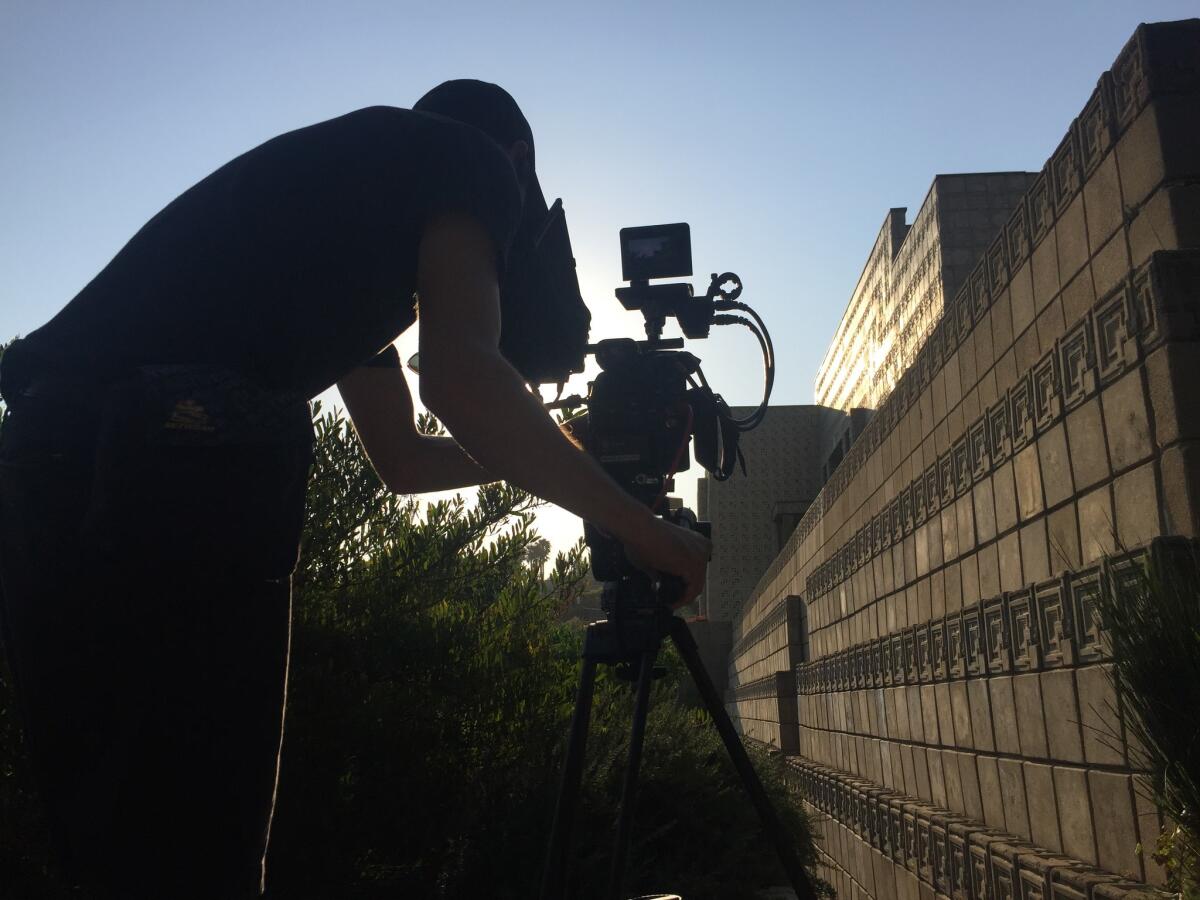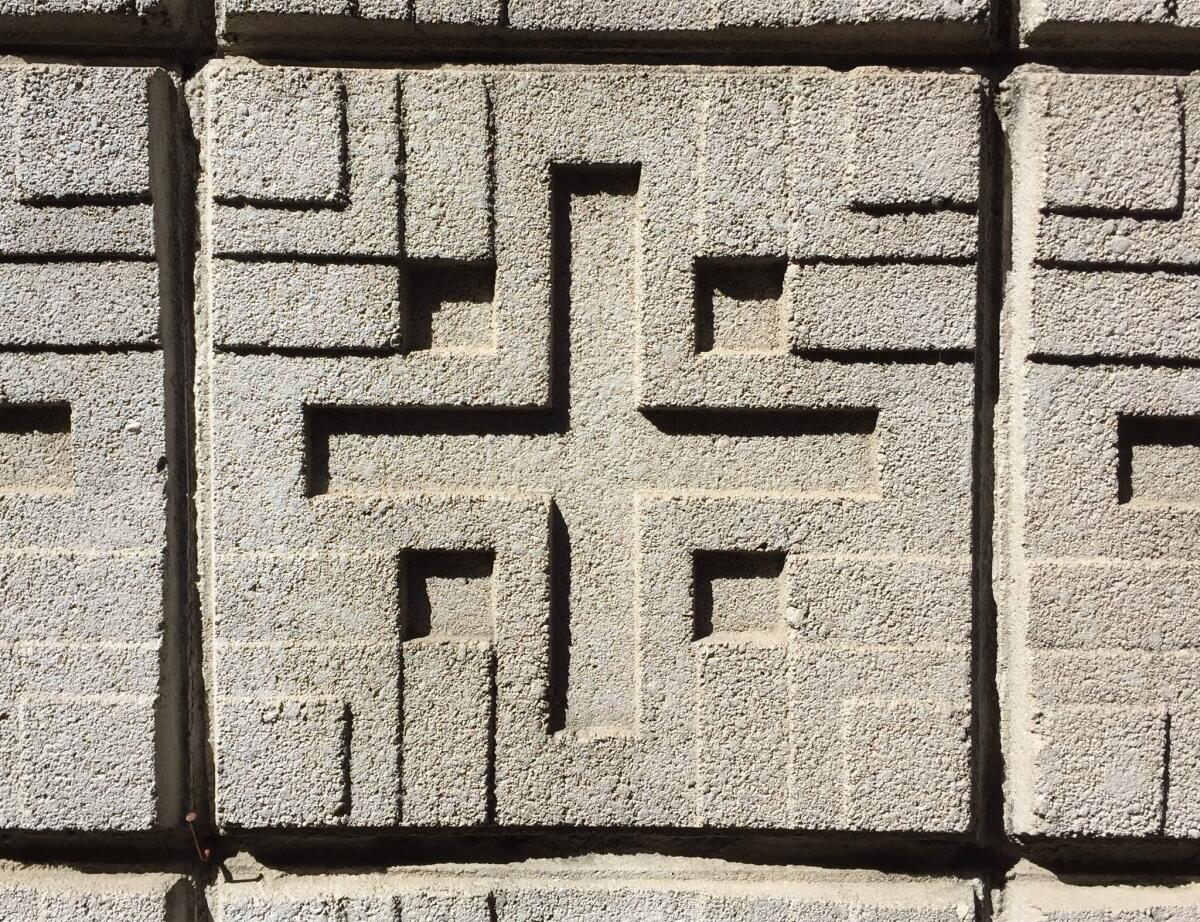How I tried to crack the mysterious case of Frank Lloyd Wright’s Los Angeles houses
What was I thinking?
I have to admit that over the last few months, in finishing the job of writing and directing “That Far Corner,” an hour-long documentary for KCET-TV on Frank Lloyd Wright’s Los Angeles houses, I’ve had some seriously reflective and even hesitant moments.
Why did I think I was qualified to tell the on-screen story of Wright’s quixotic L.A. work, so different in style and structural logic from the famous Prairie houses he produced in the Midwest? Why focus on Wright, American architecture’s equivalent of Abraham Lincoln, the giant who casts a shadow over his field big enough to blot out smaller and underrepresented figures? And why now, just as the spotlight turned on the architect last year, during the 150th anniversary of his birth, was beginning to fade?
The answer I’ll give here is essentially the same one I give in the documentary, which will air for the first time on Tuesday evening to kick off the ninth season of KCET’s Artbound series: Because the architect’s brilliant if forbidding Southern California houses, the most important of which were designed in a burst of creative energy during the first few months of 1923, remain mysterious, their meaning and inspiration as opaque as their heavy, richly patterned concrete-block facades. And because I wanted to explore the relationship between the tragedy that immediately preceded Wright’s decision to travel to Southern California for the first time — the gruesome murder at Wright’s Taliesin studio of Mamah Borthwick, the woman he left his wife for in 1909 — and the architecture he produced not long after in L.A.
That connection struck me as a compelling but under-examined one in the nearly endless scholarship about Wright’s career. The title I chose, “That Far Corner,” comes from a phrase Wright used in his autobiography to describe Southern California; it suggests just how much L.A.’s remoteness appealed to Wright at that moment in his life and career. Here he could find some distance from the prying Midwestern journalists who saw his relationship with Borthwick and its tragic end as tabloid fare.
That’s not to say that a number of historians haven’t traveled down the same path I did. The most indispensable interviews I conducted for the documentary were with local writers and scholars — Kathryn Smith, Robert Sweeney and the great UCLA historian Thomas S. Hines, to name three — who have dedicated significant portions of their careers to studying Wright’s work in Southern California.
But even they stressed not how much we know about Wright’s time in L.A. but how much we don’t. When I asked Smith about the brown-shingle house on Harper Avenue (in what is now West Hollywood) that Wright rented as an office and studio in early 1923, she laughed.
“Well, at the time that it was up for sale [in the 1980s] and Robert Sweeney and I visited it, I think in all of Los Angeles, in all of America, in all of the world, only two people knew that it was Frank Lloyd Wright's studio,” she said. “That was Robert Sweeney and me. And up to now, you are the only other person who's ever been interested in it.” The house was demolished in 1987.

What’s more, the precise source of the pre-Columbian designs stamped on the concrete blocks of those 1923 houses is either unknown or remains the subject of informed guesswork — even for experts. Los Angeles County Museum of Art curator Megan O’Neil told me the cross embedded in the blocks at the Millard House, in Pasadena, could well be a reference to a pre-Columbian obsession with “measuring out the sides of the universe,” which is to say a kind of map with each end of the cross pointing to one of the cardinal directions.
After a pause, she added, “But that specific design is also the symbol for gold for the Aztecs,” indicating that perhaps Wright used the pattern to suggest “concrete turning into gold — this sort of transubstantiation.”
By contrast, Hollywood and popular culture have offered a clear read on Wright’s L.A. work from the start. A remarkable number of the films shot at the Ennis House in Los Feliz, the biggest of the concrete-block designs, have a connection to crime, death or dystopia, among them “Blade Runner,” “The Day of the Locust” and “The Replacement Killers.”
Was there some link between the violence in Wright’s personal life that sent him careening to California and the work he produced here? And what was it about pre-Columbian ruins that made them so attractive to Wright in the 1920s as the basis for an experimental, concrete-block L.A. architecture?

It was precisely in my approach to answering those questions that I thought I could offer a fresh perspective on Wright’s architecture. What I lacked in directing experience (everything!) I hoped to make up for by bringing to bear on Wright’s Los Angeles work the combination of reporting and informed speculation that drives all effective architecture criticism. I wanted to be on firm ground in terms of my understanding of Wright’s career — of the work that paved the way for the L.A. houses — but also ready to take a speculative leap if necessary to pose some new questions about what the houses mean.
So what was I thinking? I was thinking that it was precisely in the gap between academic protocol and critical prerogative — between what historians are required to do and what critics are allowed to do — that a new understanding of Wright’s L.A. work might emerge.
The late critic Brendan Gill was a model for me in this regard; though his 1987 biography of Wright, “Many Masks,” is not beloved by historians, his perceptive reading of the buildings themselves has held up remarkably well. When he argued that Wright’s L.A. houses were “better suited to sheltering a Mayan god than an American family,” he was picking up on something significant that other biographers have overlooked.
Ada Louise Huxtable’s short biography for Penguin, published in 2004, was another reminder that critics have a particular role to play alongside historians in making sense of Wright’s tumultuous life and restless, unorthodox approach to making architecture. There’s a difference between explaining the genesis of a building and explaining its meaning.
I was also thinking that it would be fascinating to try making a critical argument about architecture with a Steadicam instead of a keyboard. The most compelling conversations I had with the talented (and intimidatingly young) group I worked with — including director of photography Travis LaBella, producer Jacqueline Reyno, editor Collin Davis and composer Adam Schoenberg — were about this specific question, how to build and sustain a work of architecture criticism with images, music and pacing in place of words on the page.
One strategy I settled on, along those lines: To emphasize the rootedness of the houses, their solidity and heaviness, we decided to capture them from below as much as possible, sometimes at extreme angles. No drone shots.
After recording interviews with nearly 20 people and filming inside eight Wright buildings — four in L.A. and four in the Midwest — I’m hopeful that the final product will be revealing even for Wright scholars. I don’t say that anticipating that every one of them will agree with the theory about the houses I lay out in “That Far Corner.” (I even give one of them some on-screen time to take issue with it.) My overarching goal was to bring some new, sustained attention to a group of houses that have lingered too long, given their importance to the American architectural canon, in the relative shadows.
Tune in to KCET on Tuesday evening (or online here) to decide what you make of that theory — and to catch cameos by Martha Stewart and Alan Rickman (as Hans Gruber). A bonus, for architecture buffs: Several of the interviews in “That Far Corner” take place inside important houses by architects other than Wright. See if you can spot residential designs by Rudolph Schindler, the duo of Charles Moore and William Turnbull and — in two cases — Richard Neutra. There’s also a trip, near the end, to the Malibu compound owned by Eric Lloyd Wright, Frank Lloyd Wright’s grandson and, at age 88, still very much a formidable presence in his own right.
“That Far Corner: Frank Lloyd Wright in Los Angeles” airs at 9 p.m. Tuesday on KCET-TV.
Twitter: @HawthorneLAT
The biggest entertainment stories
Get our big stories about Hollywood, film, television, music, arts, culture and more right in your inbox as soon as they publish.
You may occasionally receive promotional content from the Los Angeles Times.








